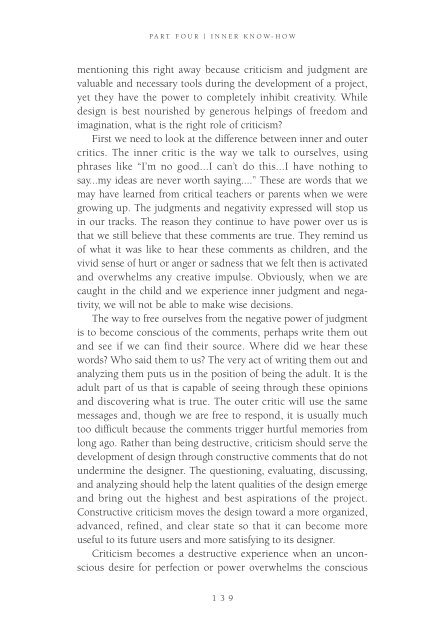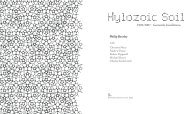The Inner Studio - Riverside Architectural Press
The Inner Studio - Riverside Architectural Press
The Inner Studio - Riverside Architectural Press
Create successful ePaper yourself
Turn your PDF publications into a flip-book with our unique Google optimized e-Paper software.
PART FOUR | INNER KNOW-HOW<br />
mentioning this right away because criticism and judgment are<br />
valuable and necessary tools during the development of a project,<br />
yet they have the power to completely inhibit creativity. While<br />
design is best nourished by generous helpings of freedom and<br />
imagination, what is the right role of criticism?<br />
First we need to look at the difference between inner and outer<br />
critics. <strong>The</strong> inner critic is the way we talk to ourselves, using<br />
phrases like “I’m no good...I can’t do this...I have nothing to<br />
say...my ideas are never worth saying....” <strong>The</strong>se are words that we<br />
may have learned from critical teachers or parents when we were<br />
growing up. <strong>The</strong> judgments and negativity expressed will stop us<br />
in our tracks. <strong>The</strong> reason they continue to have power over us is<br />
that we still believe that these comments are true. <strong>The</strong>y remind us<br />
of what it was like to hear these comments as children, and the<br />
vivid sense of hurt or anger or sadness that we felt then is activated<br />
and overwhelms any creative impulse. Obviously, when we are<br />
caught in the child and we experience inner judgment and negativity,<br />
we will not be able to make wise decisions.<br />
<strong>The</strong> way to free ourselves from the negative power of judgment<br />
is to become conscious of the comments, perhaps write them out<br />
and see if we can find their source. Where did we hear these<br />
words? Who said them to us? <strong>The</strong> very act of writing them out and<br />
analyzing them puts us in the position of being the adult. It is the<br />
adult part of us that is capable of seeing through these opinions<br />
and discovering what is true. <strong>The</strong> outer critic will use the same<br />
messages and, though we are free to respond, it is usually much<br />
too difficult because the comments trigger hurtful memories from<br />
long ago. Rather than being destructive, criticism should serve the<br />
development of design through constructive comments that do not<br />
undermine the designer. <strong>The</strong> questioning, evaluating, discussing,<br />
and analyzing should help the latent qualities of the design emerge<br />
and bring out the highest and best aspirations of the project.<br />
Constructive criticism moves the design toward a more organized,<br />
advanced, refined, and clear state so that it can become more<br />
useful to its future users and more satisfying to its designer.<br />
Criticism becomes a destructive experience when an unconscious<br />
desire for perfection or power overwhelms the conscious<br />
139





